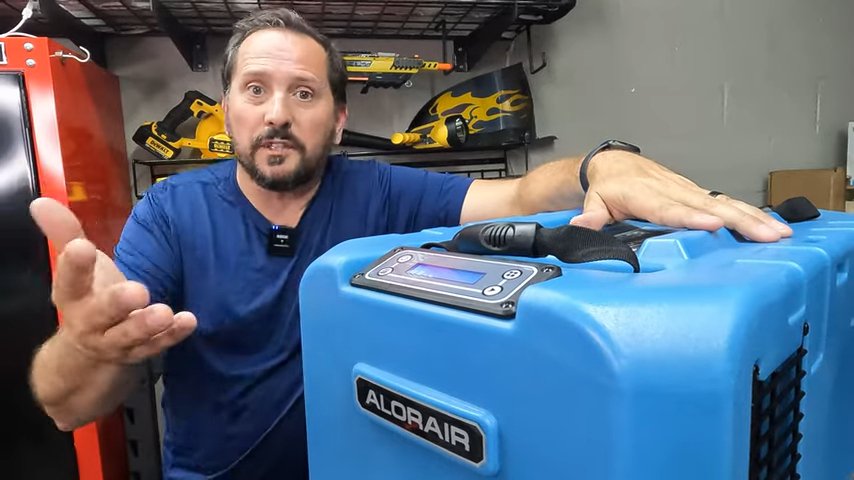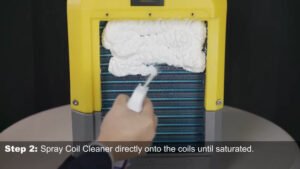Indoor humidity control in workplaces is rarely glamorous, yet it affects corrosion, product quality, worker comfort, microbial growth, and even the accuracy of sensitive processes. “Keep indoor humidity between 30 and 50 percent,” the U.S. Environmental Protection Agency advises. (US EPA) ASHRAE adds a ceiling: “relative humidity in occupied spaces be controlled to less than 65% to reduce the likelihood of conditions that can lead to microbial growth.” (ASHRAE) Those two sentences frame the target band for many commercial spaces, though some industries run drier or wetter by design. The pages that follow outline how to select, install, and maintain equipment that can actually hold those numbers.
1. Industrial dehumidifier types

Refrigerant (mechanical) systems. These units cool air below its dew point, condense water on coils, and reheat the air slightly. Performance falls as coil temperature approaches freezing. A retail guide states that “freezing can occur at any temperature from about 65°F/18°C downward,” which captures the practical drop-off many facility managers see. (Breathing Space)
Desiccant systems. A hygroscopic wheel or bed absorbs water vapor, then a reactivation heater drives it off. A trade article notes that desiccant units “excel in cold environments where refrigerant dehumidifiers lose efficiency,” such as cold storage and warehouses below 18 °C. (moisturecurecommercial.com.au) Another source sums it up bluntly: “Desiccant units work well in cooler temperatures. They can function effectively even when room temperatures drop below 10 °C.” (Commercial Cleaning Depot)
Hybrid and specialized dehumidifiers. Some manufacturers pair a small DX coil with a desiccant wheel to trim reactivation energy or to reach very low dew points. NREL’s review of desiccant technology describes such add-on modules as a way to meet higher ventilation rates and tighter humidity control while reducing peak electric demand. (NREL Docs)
These distinctions feed a common search phrase—desiccant vs refrigerant dehumidifiers—and for good reason. Selecting the wrong core technology often locks a facility into higher energy bills or poor low-temperature dehumidification for years.
2. Capacity, air volume, and “dehumidifier capacity calculator” math
Sizing is not guesswork. At minimum, three numbers matter: incoming air moisture content, target humidity, and airflow through the machine.
- Moisture load is often expressed in pounds of water per hour or grains per hour. “1 pound water = 7,000 grains.” (condair.com) Engineers compute the difference in humidity ratio (grains/lb dry air) between entering and leaving air, multiply by airflow, and divide by 7,000 to get pounds/hour. That is your determining moisture load step.
- Selecting CFM rating. Airflow must move enough cubic feet per minute through the coil or desiccant bed to capture the latent load. Manufacturer literature ties CFM to required air changes per hour (ACH). (BaseAire) In warehouses or production areas, sizing for warehouse space usually starts with volume (ft³), desired ACH, and moisture sources (open water tanks, curing concrete, infiltration).
- Industrial humidity requirements vary. ASHRAE Standard 55 limits the comfort zone to a humidity ratio =0.012 kg H2O/kg dry air. (ASHRAE) In IT spaces, ASHRAE TC 9.9 recommends 18–27 °C inlet air temperatures; humidity is controlled to protect electronics from corrosion and static. (ASHRAE)
If you want a quick dehumidifier capacity calculator approach for a warehouse:
- Find current humidity ratio (w1) and target ratio (w2) from a psychrometric chart.
- ?w = w1 – w2 (lb water/lb dry air).
- Moisture load (lb/h) = 60 × CFM × ?w / 4.5 / 7000 (using 0.075 lb/ft³ air density and 4.5 for HVAC latent heat constants). This simplified relation comes from ASHRAE fundamentals airflow conventions. (ASHRAE)
- Pick a high-capacity moisture extractor that meets or exceeds that lb/h number at your entering conditions.
3. Operation strategy: continuous vs intermittent operation
Industrial brochures promise “constant duty cycle operation” for rugged units, meaning 24/7 run capability without cycling limitations. (Dehumidifier Corporation of America)(Sylvane) Light-duty units use a humidistat that starts and stops the compressor or heater—intermittent operation—which saves energy during mild weather but can yield wider humidity swings.
Energy models should capture start/stop losses, especially in reheat systems, so a plant manager evaluating long-term ROI cannot just multiply nameplate amps by hours. Data trending after install often shows whether stepping to continuous fan with staged refrigerant (or a VFD) tightens control at a lower kWh per removed pound of water.
4. Ambient temperature considerations and low-temperature dehumidification
Cold rooms, curing tunnels, or unheated loading docks drive many buyers toward desiccants. Blogs, manufacturer guides, and testing labs all repeat the same threshold: mechanical coils ice up at or below the mid-teens Celsius. (Breathing Space)(Meaco Blog)(moisturecurecommercial.com.au) If a site swings seasonally, a hybrid or a refrigerant unit with hot-gas bypass and aggressive defrost logic can still work, but verify the published performance map rather than relying on a single “pints per day” number recorded at 80 °F/60% RH.
5. Portable commercial units vs fixed installation dehumidifiers
Portable commercial units roll between spaces, plug into standard circuits, and offer fast deployment after a leak or during construction drying. They fit restoration contractors and temporary set-ups.
Fixed installation dehumidifiers tie into ductwork, may hang from structure, and often require condensate pumps, dedicated circuits, and BMS integration. The Aprilaire E-series manual, for instance, details optional W/Y terminal wiring into HVAC controls and duct collar placement “to prevent short-circuiting dehumidified air directly back to the dehumidifier inlet.” (radonaway.com)
Application drives that choice:
- Museums and archives need quiet, steady units with tight control.
- Pools and natatoriums need corrosion-resistant coils and large latent capacity.
- Food processing often needs washdown-ready housings—specialized dehumidifiers.
6. Energy-efficient models and SEER vs EER explained
A dehumidifier is essentially an HVAC sub-system. Two well-known metrics describe cooling efficiency:
- “The seasonal energy efficiency ratio (SEER) is the ratio of the total heat removed from the conditioned space during the annual cooling season divided by the total electrical energy consumed…” (U.S. Department of Energy brochure). (The Department of Energy’s Energy.gov)
- “Energy Efficiency Ratio (EER). A ratio of the Cooling Capacity in Btu/h to the power input values in watts at any given set of Rating Conditions…” (AHRI Standard 340/360). (ahrinet.org)
SEER vs EER explained: SEER averages performance over a season; EER is a single-point full-load rating. For commercial dehumidifiers that run at a fairly steady latent load, EER (or its updated EER2 variant) often tells more about peak efficiency, while SEER can flatter equipment that cycles.
True energy comparison needs kWh per pound of water removed at your site conditions. Some energy-efficient models publish that metric directly.
7. Site preparation steps
Before the unit arrives:
- Confirm slab or structure can handle weight and vibration.
- Plan forklift or lift paths for large frames.
- Lay out ducting and airflow setup—the AMG Air manual warns: “All duct connections must be sealed. Any air leakage in the duct work will adversely affect the operation of the dehumidifier and may lead to unsatisfactory performance.” (AMG Air)
- Map electrical requirements. NEC 210.8 requires GFCI protection for receptacles in specific areas like garages and outdoors. (electricallicenserenewal.com) Large fixed units may fall under different articles (NEC 440 for A/C and refrigeration equipment).
- Draft a safety compliance checklist covering lockout/tagout, condensate disposal, and clearance around the cabinet. OSHA’s IAQ page reminds facility managers that ventilation and building care prevent IAQ problems, even though OSHA has no specific humidity rule. (OSHA)
8. Condensate drainage options
Gravity drain into a floor sink, pumped discharge to a standpipe, or direct connection to a sanitary line each carry code nuances.
A manufacturer manual states: “Slope the condensate drain line with a minimum of 1/4 inch per foot. A P-trap is recommended.” (Dehumidifier Corporation of America) The International Plumbing Code section 704.1 lists minimum slopes for horizontal drainage piping (1/4 in/ft for small diameters). (ICC Digital Codes) Keep lines accessible for drain line unclogging. Algae gels and scale are routine.
9. Mounting best practices and placement optimization
Hang units with vibration isolation pads or springs to manage noise transfer. ASHRAE’s sound guidance says HVAC noise must be “of sufficiently low level and unobtrusive quality so as not to interfere with occupancy use requirements.” (ThermAir Systems) Piping and ductwork should avoid rigid connections that transmit vibration; engineers “specify springs or rubber pads to isolate the equipment.” (Pumps and Systems Magazine)
Placement rules of thumb:
- Leave clearance for coil pulls and filter removal.
- Avoid corners where short-circuiting occurs.
- Keep intakes away from pollutant sources (forklift chargers, chemical baths).
10. Professional installation tips vs DIY installation pitfalls
Professional installation tips
- Follow manufacturer torque specs on refrigerant fittings; leak checks with nitrogen and soap are far cheaper than refrigerant loss.
- Use megohm meters on compressor motors before energizing older stock.
- Document sensor placement; routing long humidistat leads next to VFD power can induce noise.
DIY installation pitfalls
- Undersized wiring or lack of dedicated circuits tripping breakers.
- Missing traps on condensate lines causing air bypass and poor drainage. (Dehumidifier Corporation of America)
- Ignoring system commissioning. ASHRAE Guideline 0 defines commissioning as verifying and documenting that systems are “planned, designed, installed, tested, operated, and maintained to meet the Owner’s Project Requirements.” (ASHRAE)(ASHRAE) Skipping that step leaves latent issues hidden until peak summer.
11. Commissioning and calibration
A functional test plan should include:
- Step-load tests across humidity setpoints.
- Verification of calibration of humidistat or RH sensors. The classic “salt test” yields 75% RH with sodium chloride. (Ruuvi)(assets.omega.com) Vaisala lists other saturated salts (MgCl2 33%, K2SO4 97%) for multi-point checks. (Vaisala)
- Alarm checks and BAS trend logging.
12. Routine care and preventive maintenance checklist
Published checklists converge on similar tasks:
- Routine filter cleaning every two weeks to one month, depending on dust load. (The Sun)(partselect.com)
- Coil maintenance schedule: inspect and clean cooling coils, then let them dry before reassembly. (aireserv.com)
- Drain line unclogging: check hose kinks, clean with a pipe snake when needed. (aireserv.com)
- Refrigerant leak checks during seasonal service. Industry best practice uses electronic leak detectors on joints and Schrader valves.
- Preventive maintenance checklist items from pharma/industrial SOPs include damper position checks and recording service actions. (pharmaguidehub.com)
- Professional service intervals: at least annually, as several manuals and service guides recommend a yearly deep clean. (Rescomm PHC Inc)(aireserv.com)
Noise creeping up? Tighten panels, replace worn vibration pads, and verify fan balance—standard noise reduction techniques taught in HVAC noise control courses. (www.cedengineering.com)(Pumps and Systems Magazine)
13. Common error codes and DIY repair tips
Error codes differ, yet patterns repeat:
- E1 often references a sensor fault or humidity sensor error, per AlorAir support. (alorair.com) Other brands tie E1 to drain issues or communication errors. (JustAnswer)
- DIY repair tips: power-cycle to reset logic, reseat sensor connectors, clear condensate blockages, and consult the service manual before replacing boards.
Keep a binder—or digital folder—with all manuals so technicians can cross-reference codes quickly.
14. Commercial dehumidifier comparison: application-specific dehumidifiers
Instead of a brand list, compare by application class:
| Application | Target RH / Dew Point | Typical Technology | Key Options | Notes |
|---|---|---|---|---|
| Cold storage, blast freezers | RH often <40% at <10 °C | Desiccant | Electric or gas reactivation, stainless housings | Low-temperature dehumidification needed. (moisturecurecommercial.com.au) |
| Warehouses, distribution centers | 40–60% RH band | Refrigerant or hybrid | High CFM blowers, duct collars | Sizing for warehouse space depends on infiltration loads. (ASHRAE) |
| Data centers | Dew point control for static/corrosion | Precision refrigerant with reheat or DX coils plus steam humidifiers | BACnet integration, dual sensors | ASHRAE TC 9.9 guidance. (ASHRAE) |
| Pools/natatoriums | 50–60% RH, high latent | Refrigerant with heat recovery | Corrosion-resistant coils | Chloramines demand special coatings. |
| Pharmaceuticals/cleanrooms | Tight ±2% RH bands | Desiccant or hybrid | HEPA filtration, stainless internals | Regulatory documentation required. |
This commercial dehumidifier comparison frame clarifies trade-offs better than marketing claims.
15. Electrical requirements guide and safety compliance checklist
Key points to log for the safety compliance checklist:
- Circuit ampacity, disconnect location, and lockout points.
- GFCI or GFPE where NEC requires. (electricallicenserenewal.com)
- Bonding of condensate pumps if metallic.
- Clearance to meet manufacturer service specs.
- Condensate disposal per local code. (Dehumidifier Corporation of America)(ICC Digital Codes)
16. System commissioning and documentation
ASHRAE Guideline 0/Standard 202 emphasize checklists “developed and used during all phases of the Commissioning Process.” (ASHRAE) Capture:
- Submittal review sign-offs
- Functional test scripts
- Trend log points and durations
- Warranty terms and spare parts list
That binder (digital or paper) pays for itself during the first service call.
17. Long-term ROI
Capital cost is only the first line. Dehumidifiers pull significant latent loads, so kWh, service labor, and downtime risk become the real expense. Desiccant wheels need reactivation heat—often gas or steam. Refrigerant systems add compressor maintenance and leak monitoring. Hybrid approaches can cut peaks or use waste heat for regeneration. A credible ROI model includes:
- Energy use in kWh or therms per pound of water removed.
- Service hours per year (based on the preventive maintenance checklist).
(pharmaguidehub.com)
(Rescomm PHC Inc) - Productivity or product scrap avoided by staying within humidity control guidelines.
(US EPA)
(ASHRAE)
Many buyers find that spending more on control integration (better sensors, trend logging) reduces wasted run time.
18. Quick-reference checklist
- Confirm target RH and any industry-specific limits (EPA 30–50%, ASHRAE <65% for most occupied areas).
(US EPA)
(ASHRAE) - Pick core technology: desiccant vs refrigerant dehumidifiers based on ambient temperature and dew point goals.
(moisturecurecommercial.com.au)
(Breathing Space) - Run a dehumidifier capacity calculator using grains or humidity ratio. “1 pound water = 7,000 grains.”
(condair.com) - Verify airflow: selecting CFM rating to hit desired ACH.
(BaseAire) - Decide on portable commercial units or fixed installation dehumidifiers.
(radonaway.com)
(Dehumidifier Corporation of America) - Check electrical requirements (NEC), condensate drainage options, and physical mounting.
(Dehumidifier Corporation of America)
(electricallicenserenewal.com)
(ICC Digital Codes) - Plan system commissioning with ASHRAE checklists.
(ASHRAE) - Set up a preventive maintenance checklist: filters, coils, drains, sensors.
(aireserv.com)
(partselect.com)
(pharmaguidehub.com) - Train staff on common error codes and DIY repair tips (sensor E1, drain faults).
(alorair.com)
(JustAnswer) - Track energy performance; include SEER vs EER explained in staff training for clarity.
(The Department of Energy’s Energy.gov)
(ahrinet.org)
A commercial dehumidifier is more than a box that “pulls pints per day.” It is part of a humidity control system with psychrometrics at its core, electrical and plumbing touches at its edges, and human operations holding it together. Pick the right type, size it with data, install it to code, commission it with a checklist, and keep it tuned. The room stays dry, people stay safe, and the balance sheet looks better for years (US EPA) (ASHRAE).
19. Top Rated Commercial Dehumidifiers
250 Pint Commercial Dehumidifier w/ Pump (8000 sq ft)
Full review of 250 Pint Commercial Dehumidifier w/ Pump (8000 sq ft)
Evaluation:
This class of very high-capacity dehumidifier is built to move the needle in large, saturated commercial environments (˜8,000 sq. ft.), delivering up to 250 pints per day at saturation while still being capable of driving relative humidity very low when paired with sufficient airflow. Units in this tier typically combine high CFM circulation (some designs advertise 445 CFM to speed equilibrium) with pumped drainage, auto-defrost, and rugged housings to survive restoration and industrial duty. The design philosophy mirrors best practices for structural drying—heavy throughput with continuous drainage and resilient controls. (Waykar) (candrmagazine.com)
Pros:
- Huge bulk removal capacity for large, water-logged areas.
- Pumped drainage supports flexible installation.
- High airflow accelerates drying equilibrium.
Cons:
- Size/weight and heat rejection require planning in constrained spaces.
- Higher power draw; matching to real load is essential to avoid cycling inefficiencies. (Air Scrubber HQ)
TURBRO 165 Pint Commercial Dehumidifier w/ Pump (7500 sq ft)
Full review of TURBRO 165 Pint Commercial Dehumidifier w/ Pump (7500 sq ft)
Evaluation:
The TURBRO 165-pint model balances substantial coverage (˜7,500 sq. ft.) with features tuned for restoration and commercial environments: built-in pump, faster defrost cycles, rolling mobility, and digital control. The manufacturer positions it for job sites where minimizing downtime (via rapid defrost and continuous drainage) is a priority. Users and secondary summaries in trade contexts note its capacity for high humidity extraction under severe conditions, consistent with what mid/high-tier commercial dehumidifiers aim to deliver. (TURBRO) (Wayfair) (Reddit)
Pros:
- Strong middle-ground capacity with smart defrost and drain features.
- Designed for continuous, heavy use with mobility in mind.
Cons:
- Not an LGR system—less deep-drying precision when air is already drying out.
- Buyers should validate sensor accuracy and support given variability in mid-brand ecosystems. (Reddit)
ALORAIR 180 PPD LGR Commercial Dehumidifier w/ Pump – Editor’s Choice
Full review of ALORAIR 180 PPD LGR Commercial Dehumidifier w/ Pump
Evaluation:
An LGR-based machine optimized for restoration and high-precision drying, this AlorAir unit removes 180 pints per day at saturation and maintains efficiency as humidity drops, thanks to its dual cooling/pre-conditioning and low grain depression design. Features like app/LCD control, heavy-duty integrated pump, and compact contractor-friendly footprint make it a go-to for flood and mold remediation professionals. Its technology suite reflects the documented advantages of LGR over standard refrigerant systems in achieving lower grains per pound and sustaining extraction in challenging conditions. (alorair.com) (alorair.com) (preair.com) (hzhongtai.com)
Pros:
- Superior low-humidity extraction via LGR core.
- Smart controls and continuous pumped drainage.
- Contractor-focused portability and warranty support.
Cons:
- Performance profile is overqualified for lightly damp large open spaces where bulk removal (not deep drying) is the priority. (hzhongtai.com)
Kesnos 155 Pint Commercial Dehumidifier w/ Pump (7500 sq ft) – Editor’s Choice
Full review of Kesnos 155 Pint Commercial Dehumidifier w/ Pump (7500 sq ft)
Evaluation:
Kesnos’s 155-pint unit is built for mid-to-large commercial areas and emphasizes user convenience—auto-defrost, intelligent humidity sensing, 24-hour timer, and a built-in pump for continuous operation. Its official product literature highlights portability, modern controls, and a layered support/warranty ecosystem, positioning it as a practical, energy-aware workhorse for basements, storage areas, and job sites. Independent summaries of the PD606A reinforce that it combines ease of use with the expected extraction for its class. (Kesnos) (Kesnos) (germaphobix.com)
Pros:
- Reliable capacity for ~7,500 sq. ft. with continuous pumped drain.
- Intelligent controls and auto-defrost aid unattended runs.
- Backed by multi-tier support and warranty.
Cons:
- Conventional refrigerant design limits its ability to push to very low humidity compared to LGR units. (hzhongtai.com)
ENERGY STAR 120 Pint Dehumidifier w/ Pump (1500 sq ft)
Full review of ENERGY STAR 120 Pint Dehumidifier w/ Pump (1500 sq ft)
Evaluation:
This compact, energy-efficient unit—exemplified by crawlspace models in the 120-pint range—targets smaller spaces (˜1,500 sq. ft.) where steady humidity control and power economy are desired. Designs like the AlorAir Sentinel HD (120 pint/55 AHAM) demonstrate how a smaller form factor can still deliver robust removal while fitting through tight access points and minimizing electrical impact. Pumped drainage makes it suited for below-grade or constrained installations where manual bucket emptying would be impractical. (AlorairCrawlspace) (Consumer Reports)
Pros:
- Efficient footprint with strong removal for its size.
- Pumped drainage enhances flexibility in placement.
Cons:
- Coverage is limited; multiple units may be needed for larger or very wet areas. (Sylvane)
Kesnos 158 Pint Commercial Dehumidifier w/ Pump (7500 sq ft)
Full review of Kesnos 158 Pint Commercial Dehumidifier w/ Pump (7500 sq ft)
Evaluation:
The 158-pint Kesnos model is a close sibling to the 155, offering marginally higher throughput while retaining the same core conveniences: pump, auto-defrost, and automated humidity control. Official materials emphasize durability, efficient extraction across large footprints, and straightforward operation for commercial and residential-grade large spaces. (Kesnos) (Kesnos)
Pros:
- Slightly elevated capacity for similar coverage.
- Proven control and drainage feature set.
Cons:
- As with the 155, lacks LGR depth for extreme low-humidity targets; differentiation may be subtle in practice. (hzhongtai.com)
SAHAUHY 158 Pint Dehumidifier w/ Pump (4500 sq ft)
Full review of SAHAUHY 158 Pint Dehumidifier w/ Pump (4500 sq ft)
Evaluation:
SAHAUHY’s 158-pint commercial unit is tuned for denser loads in somewhat smaller footprints (˜4,500 sq. ft.), incorporating remote monitoring, adjustable humidity setpoints, auto-defrost, and pumped drainage. The official specification highlights full range humidity control and contractor-grade deployment flexibility. User-facing reviews and video walk-throughs corroborate its effective extraction, quietness, and usability in crawlspaces or basements. (sahauhy) (sahauhy) (YouTube)
Pros:
- Remote monitoring for hands-off oversight.
- High extraction density for its stated area.
- Programmable and continuous drain features.
Cons:
- Smaller coverage radius than other 150+ pint units; proper space matching is essential.
- Brand familiarity is lower, so verifying local support and parts availability is prudent. (sahauhy)
Waykar 180 Pint Commercial Dehumidifier w/ Pump (7000 sq ft) – Editor’s Choice
Full review of Waykar 180 Pint Commercial Dehumidifier w/ Pump (7000 sq ft)
Evaluation:
Waykar’s 180-pint model aims for wide applicability in large spaces (~7,000 sq. ft.), combining high airflow (˜380 CFM), full adjustable humidity range, auto-defrost, auto-restart, and pump drainage. Its official documentation frames it as a reliable year-round environmental management unit with digital intelligence and mobility. Such features support both commercial job-site use and long-term environmental balancing. (Waykar) (Waykar)
Pros:
- Broad humidity setpoint flexibility.
- Intelligent automation reduces manual intervention.
- Balanced capacity/control for evolving ambient conditions.
Cons:
- Neither an extreme high-volume (250 PPD) nor an LGR specialist; buyers need to choose based on whether breadth or precision is primary. (Waykar)
Final Recommendations and Buying Checklist
Match capacity to real conditions. Huge spaces with heavy saturation benefit from 250 PPD class throughput; restoration tasks needing deep drying should favor the ALORAIR 180 PPD LGR. Mid-range large areas are well served by TURBRO 165, Kesnos 155/158, and Waykar 180, while the SAHAUHY fills denser, smaller zones and the ENERGY STAR–styled 120 Pint is ideal when efficiency and compactness matter. (hvacdirect.com) (Sylvane) (airchaser.com)
Drainage logistics. All featured models include pumps—nonnegotiable for flexible, continuous commercial deployment below drain level. (preair.com) (webspace.royalroads.ca) (achooallergy.com)
Control and automation. Preference should go to units with digital setpoints, auto-restart, defrost logic, and remote or smart monitoring for minimal hands-on management. (alorair.com)
Maintenance & support. Look for easy filter access, clear diagnostics, and a visible manufacturer support/warranty path—particularly with Kesnos, AlorAir, and Waykar which publicly surface those ecosystems. (Kesnos) (alorair.com)
Energy efficiency. Appropriately sized units running with efficient control reduce both power consumption and unintended heat load. Smaller “energy-styled” units avoid the waste of oversizing. (Consumer Reports) (Sylvane)
Checklist for readers:
- Is the capacity matched to square footage and vapor load? (hvacdirect.com)
- Does it have a built-in pump for needed drain flexibility? (preair.com)
- Is the underlying technology (LGR vs conventional) aligned with the drying goal? (airchaser.com) (preair.com)
- Are smart controls, defrost, and auto-restart present? (alorair.com)
- Is manufacturer support/warranty transparent and accessible? (Kesnos)
- Is routine maintenance straightforward (filter access, diagnostics)? (Kesnos)



